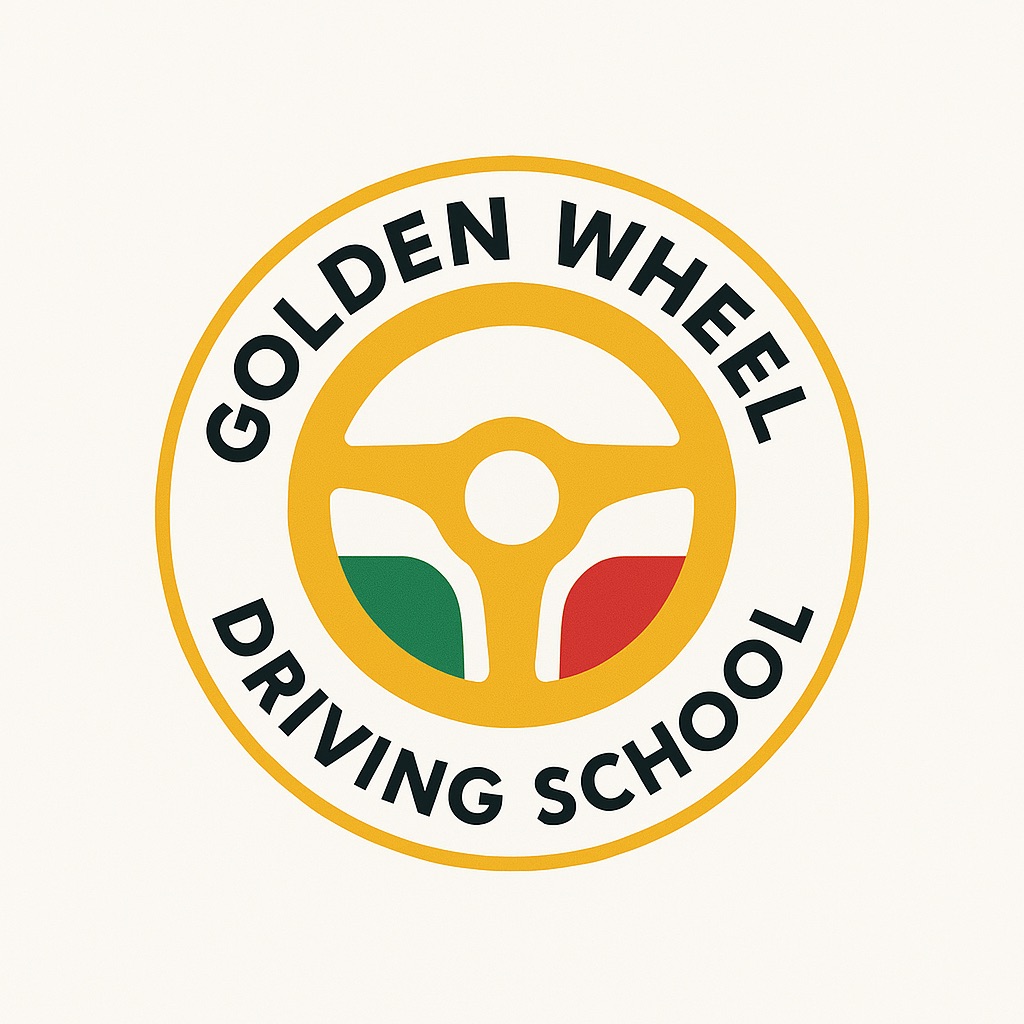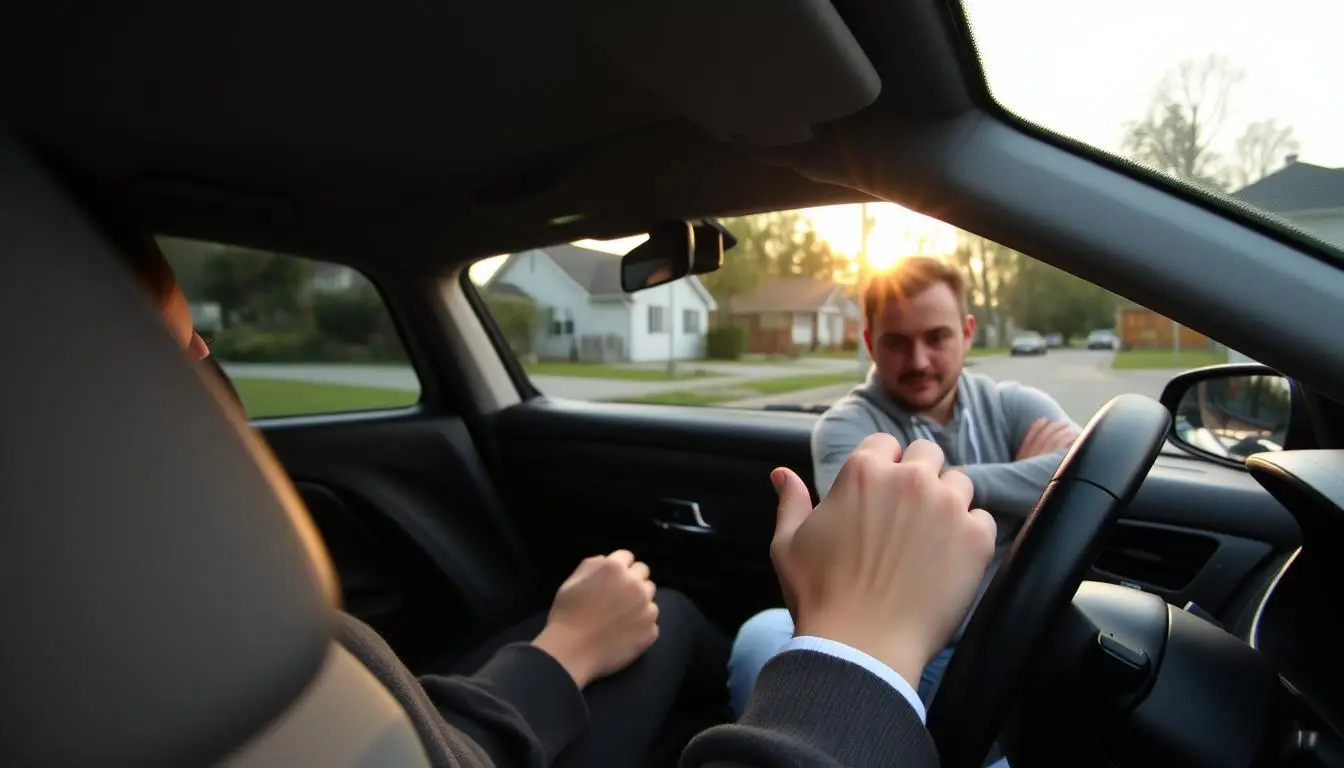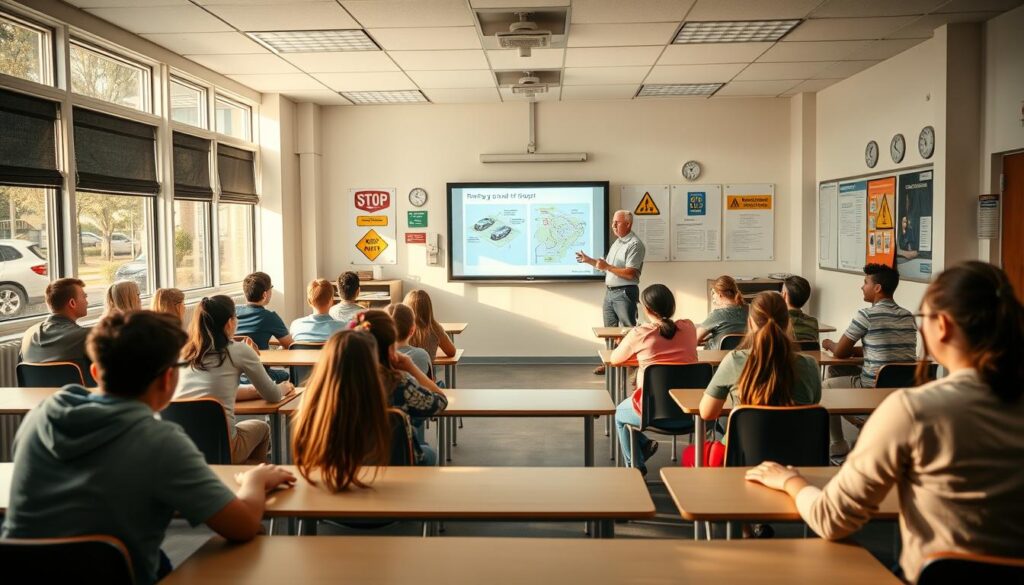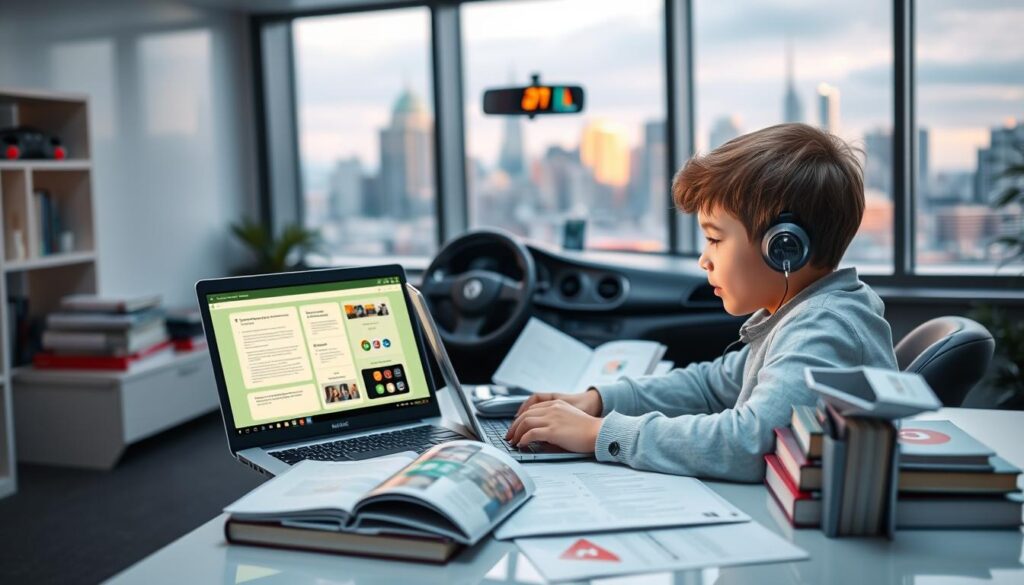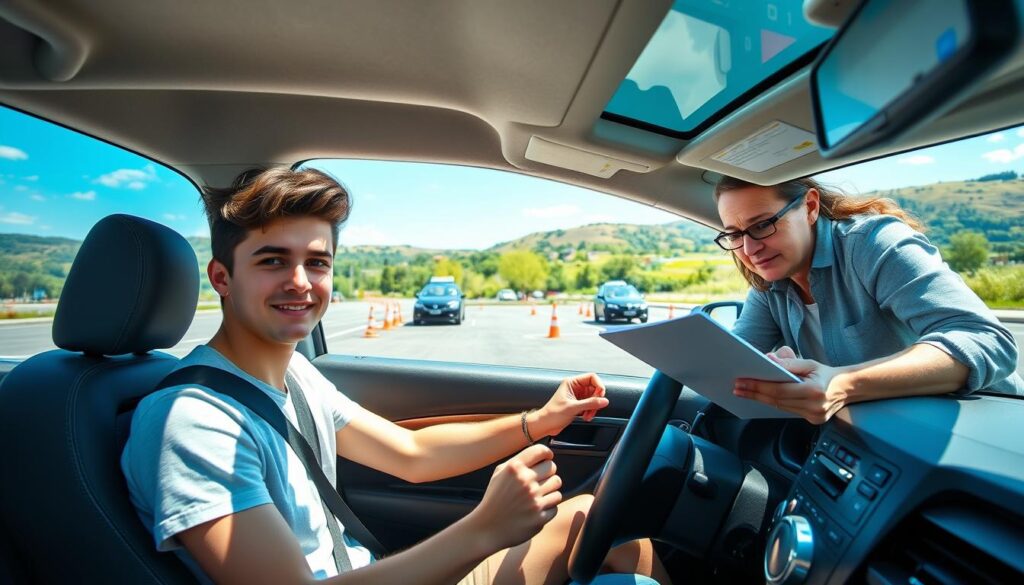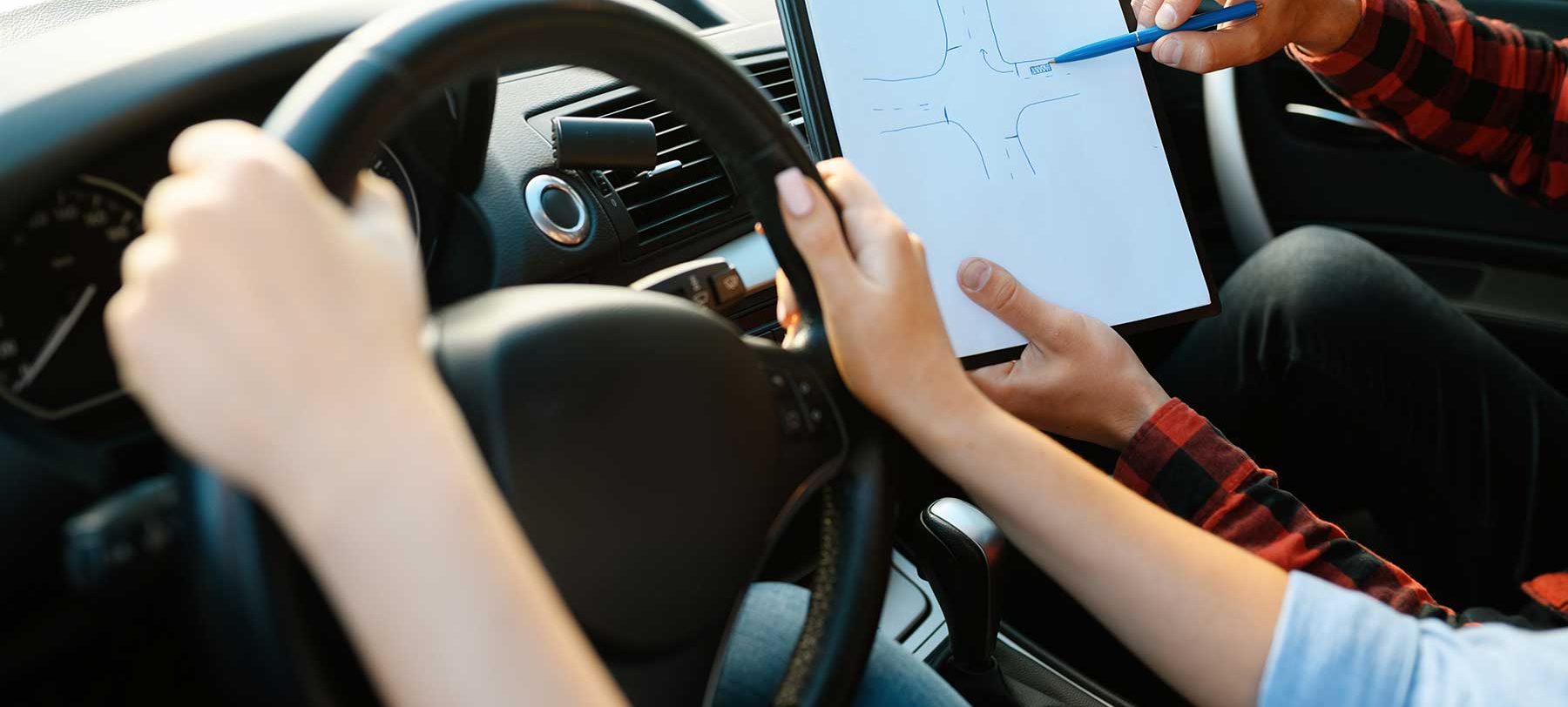Learning to drive is both thrilling and a bit scary for new drivers. As you get ready for your first driving lesson, you might feel a mix of excitement and doubt. But, with good advice and a bit of confidence, you can make this journey smooth and set yourself up for success.
This article shares tips from skilled driving instructors. They’ll help you know what to expect in your first driving lesson. We’ll talk about finding the right instructor and learning key driving skills to help you do well on the road.
Key Takeaways
- Choosing a qualified and experienced driving instructor is crucial for a productive first lesson.
- Preparing for your lesson by understanding the car’s controls and bringing the necessary documents can help you feel more confident.
- Building spatial awareness and overcoming driving-related nerves are important for developing your skills.
- Practicing in different environments, from residential areas to highways, will help you become a well-rounded driver.
- Staying focused on the road and avoiding common mistakes can ensure a safe and successful driving experience.
Choosing the Right Driving Instructor
Finding the right driving instructor is crucial for learning to drive. The instructor’s qualifications and teaching style greatly affect your learning and confidence. When looking for a driving instructor, think about these important factors.
Qualifications and Experience
Choose a driving instructor with the right qualifications and lots of experience. They should have a valid driver’s license, training certifications, and a good track record. Make sure they’ve been teaching for a while to know they’re skilled.
Teaching Style and Approach
Everyone learns differently, so pick an instructor that fits your way of learning. Some like hands-on learning, while others prefer lectures. Talk to them and see how they teach to find the best fit for you.
| Instructor Trait | What to Look For |
|---|---|
| Qualifications | Valid driver’s license, relevant training certifications, years of experience |
| Teaching Style | Interactive, hands-on approach or more structured, lecture-based method |
| Communication | Clear, patient, and effective in explaining concepts and providing feedback |
| Flexibility | Willingness to adapt their teaching style to your individual learning needs |
Think about an instructor’s qualifications, experience, and teaching style to find the right one. This will help you learn the skills and confidence you need to drive safely and responsibly.
Preparing for Your First Lesson
Starting your journey to become a confident driver requires proper preparation for your first driving lesson. This guide will help you with the essential steps to make the most of your first time driving.
What to Bring
Make sure you have these items ready for your first driving lesson:
- Valid identification, such as a driver’s license or learner’s permit
- Comfortable, non-restrictive clothing and closed-toe shoes
- A notebook and pen to jot down any important notes or instructions
- A positive attitude and an eagerness to learn
Mental Preparation
Getting mentally ready is just as important as having the right items. Here are some tips to help you feel confident and focused:
- Familiarize yourself with the car’s controls – Understand the pedals, steering wheel, and other important parts before your lesson.
- Visualize the driving experience – Picture yourself driving, following instructions, and successfully navigating the road.
- Practice deep breathing exercises – Deep breaths can help you stay calm and focused during the lesson.
Being well-prepared and mentally focused lets you fully engage in the learning process. Approach your first driving lesson with a positive mindset and a willingness to learn.
Essential Documents and Requirements
Starting your driving journey means you need the right documents and to meet certain requirements. Before your first driving lesson, make sure you have your valid ID and learner’s permit or license ready.
Valid Identification
First, make sure you have a valid ID. This could be a driver’s license, state ID card, or passport. These documents prove who you are and how old you are, which is key for driving.
Learner’s Permit or License
You also need a learner’s permit or driver’s license for driving lessons. The rules for getting these can change by state, but you usually have to pass a test on traffic laws and safety. With your learner’s permit, you can practice driving with a qualified instructor or a licensed adult.
| Documents Needed for Driving Lessons | Learner’s Permit Requirements | Driver’s License Requirements |
|---|---|---|
|
|
|
Remember, the documents needed for driving lessons, learner’s permit, and driver’s license requirements can differ by location. Always check with your local DMV or driving school for the exact details in your area.
Understanding the Car’s Controls
As a new driver, it’s key to get to know the car’s controls and features. This includes the steering wheel, pedals, and more. Knowing these basics will make driving safer and more fun.
Familiarizing with the Basics
The steering wheel is central to controlling your car. It lets you steer smoothly and stay in control. The pedals, for the brake and accelerator, control the car’s speed and stopping power. It’s important to know where they are and what they do.
The gear shift is another important part. It changes the car’s speed and power. Knowing how to use it, whether in a manual or automatic car, makes driving easier.
Getting to know other controls like the turn signals, windshield wipers, and headlights is also crucial. These help you communicate with other drivers and see the road clearly, no matter the weather.
“The more you know about your car’s controls, the better equipped you’ll be to handle any driving situation with confidence and skill.”
Learning the basics of your car’s controls is the first step to becoming a skilled driver. By getting to know the car’s features, you’re on your way to mastering car controls for new drivers, learning car controls, and basic car features for new drivers.
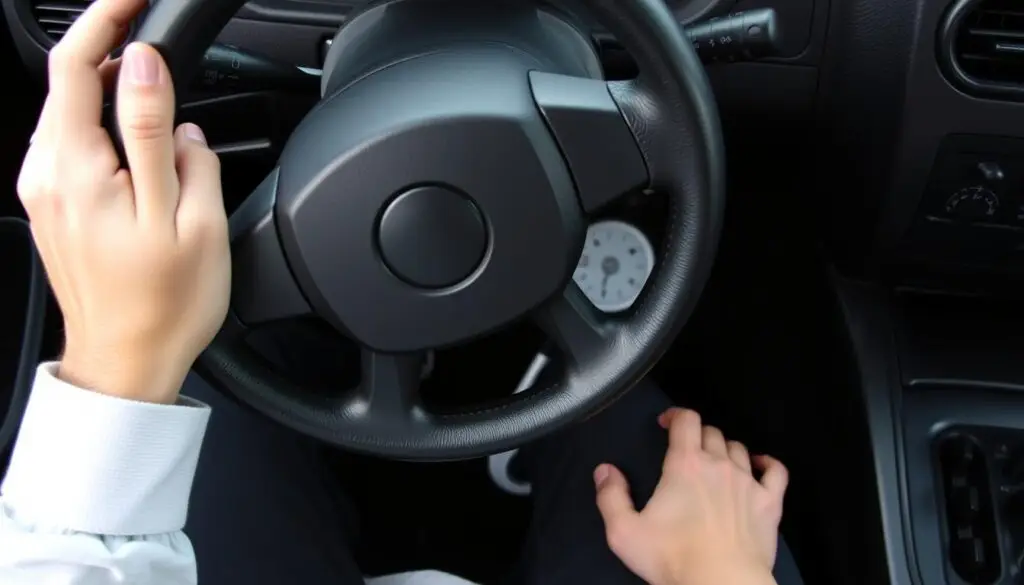
Finding the Perfect Driving Instructor
Finding the right driving instructor can change how you learn to drive. It makes you a confident, safe driver. When looking for the right driving instructor, it’s important to consider their style and how well you get along.
It’s key to find an instructor who matches well with you. They should have the right qualifications and experience. Also, they should teach in a way that fits how you learn best. Some people like a structured approach, while others prefer a more relaxed way of learning.
When picking a driving instructor, think about these things:
- Qualifications and years of experience
- Teaching style and communication skills
- Availability and flexibility in scheduling lessons
- Positive reviews and recommendations from past students
- Comfort level and rapport during the initial meeting
The right instructor can really help you feel confident on the road. Take your time to find someone who meets your needs and fits your learning style.
“The right driving instructor can transform the experience of learning to drive from a daunting task to an empowering journey.”
Building Confidence Behind the Wheel
Learning to drive can be exciting but also a bit scary for new drivers. It’s important to feel confident while driving for safety and success. We’ll look at ways to help you feel less nervous and improve your spatial awareness.
Overcoming Nervousness
It’s normal to feel anxious or unsure when you start driving. The key is to stay positive and eager to learn. Here are some tips to help you deal with driving anxiety:
- Practice deep breathing exercises before and during your lessons to stay calm and focused.
- Familiarize yourself with the car’s controls and features through self-study and practice sessions.
- Ask your instructor to provide clear, step-by-step guidance and feedback to build your confidence.
- Don’t be afraid to take breaks or request extra practice in areas where you feel less confident.
Developing Spatial Awareness
Spatial awareness means knowing where your car is in relation to other objects and vehicles. It’s key for safe driving. Here are ways to improve your spatial awareness:
- Practice regularly in different environments, such as residential areas and highways, to get a feel for how your car handles in various situations.
- Pay close attention to your mirrors and blindspots, and constantly scan your surroundings for potential hazards.
- Visualize the space around your car and anticipate the movements of other drivers and pedestrians.
- Participate in driving simulations or practice sessions that challenge your spatial awareness skills.
Building confidence behind the wheel is a journey that takes time and effort. With the right mindset, guidance from your instructor, and regular practice, you’ll become a confident and safe driver.

Common Mistakes and How to Avoid Them
As a new driver, knowing the common mistakes can keep you and others safe on the road. By knowing these mistakes, you can work on becoming a safe and responsible driver. It’s all about developing the right skills and habits.
Distracted driving is a big mistake new drivers often make. It includes texting, changing the radio, or talking with passengers. These actions can lead to serious accidents. Always keep your eyes on the road and avoid multitasking while driving.
Another big mistake is speeding. It’s key to follow speed limits and adjust your speed based on the road and weather. Speeding raises your risk of accidents and lowers your reaction time. Always drive at a safe speed, even when you’re late.
- Avoid distractions, such as texting, adjusting the radio, or engaging in conversations that can take your eyes off the road.
- Obey speed limits and adjust your driving to the prevailing road and weather conditions.
- Practice defensive driving techniques, such as maintaining a safe following distance and being aware of your surroundings.
- Familiarize yourself with the car’s controls and features, so you can operate them seamlessly without taking your attention away from the road.
By staying alert and driving safely, you can cut down on mistakes and become a confident driver. Remember, getting better at driving is a continuous process. Embrace every lesson to improve with each mile.
| Common Driving Mistakes | Strategies to Avoid Them |
|---|---|
| Distracted Driving | Keep your focus on the road, avoid multitasking |
| Speeding | Obey speed limits and adjust to road conditions |
| Lack of Defensive Driving | Maintain a safe following distance, be aware of your surroundings |
| Unfamiliarity with Car Controls | Familiarize yourself with the car’s features and controls |
Practicing in Different Environments
As you move forward in your driving lessons, it’s key to try out different places like residential streets, highways, and freeways. Getting used to various road types will boost your skills and confidence. This makes you better at handling different driving situations.
Residential Areas
Driving in neighborhoods lets you practice with stop signs, yield signs, pedestrians, and cars parked along the road. You’ll work on controlling your speed, staying alert, and making smooth turns. This helps you get better at making quick decisions and reacting fast, which is key for safe driving.
Highways and Freeways
Highways and freeways bring their own set of challenges, like merging, changing lanes, and keeping a safe distance from others. Your instructor will help you learn how to drive at faster speeds and in crowded traffic. This prepares you for the challenges of driving on big roads in real life.
